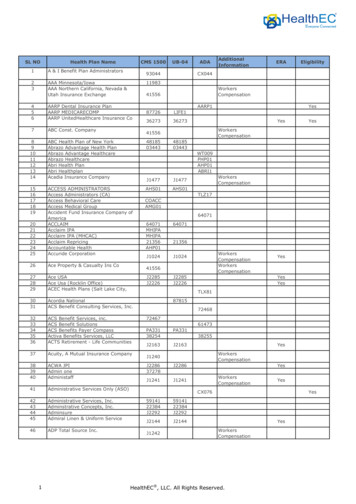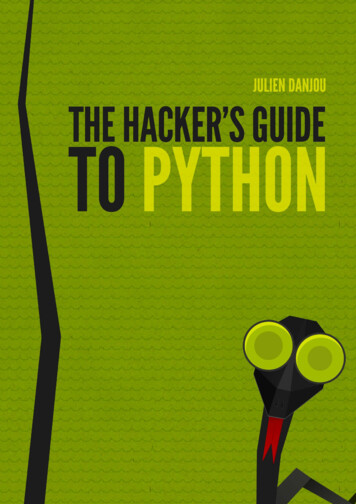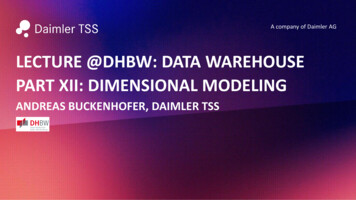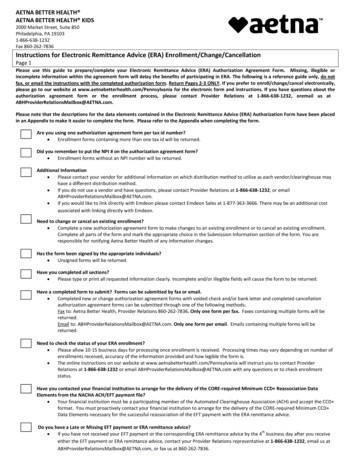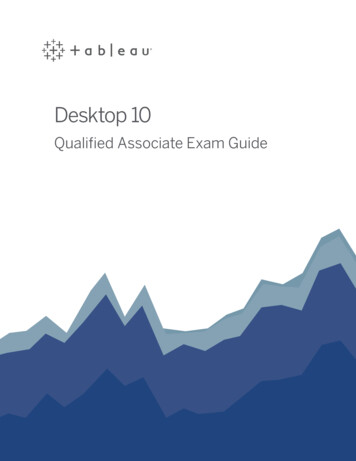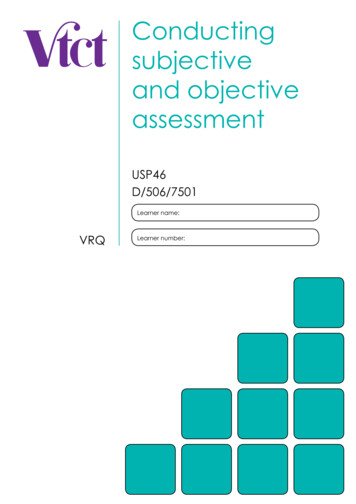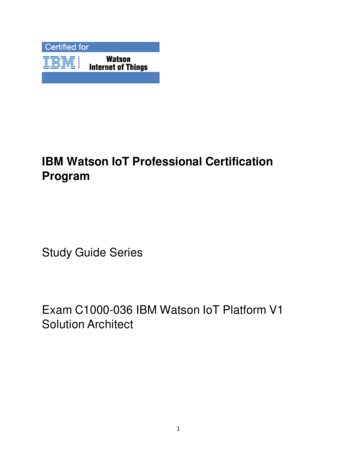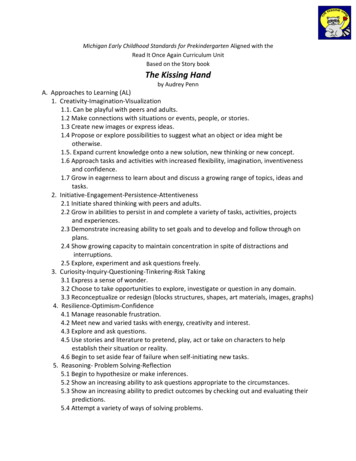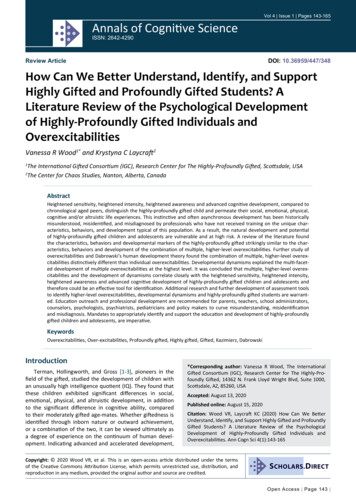
Transcription
ewVol 4 Issue 1 Pages 143-165Annals of Cognitive ScienceISSN: 2642-4290DOI: 10.36959/447/348Review ArticleHow Can We Better Understand, Identify, and SupportHighly Gifted and Profoundly Gifted Students? ALiterature Review of the Psychological Developmentof Highly-Profoundly Gifted Individuals andOverexcitabilitiesVanessa R Wood1* and Krystyna C Laycraft2The International Gifted Consortium (IGC), Research Center for The Highly-Profoundly Gifted, Scottsdale, USAThe Center for Chaos Studies, Nanton, Alberta, Canada12AbstractHeightened sensitivity, heightened intensity, heightened awareness and advanced cognitive development, compared tochronological aged peers, distinguish the highly-profoundly gifted child and permeate their social, emotional, physical,cognitive and/or altruistic life experiences. This instinctive and often asynchronous development has been historicallymisunderstood, misidentified, and misdiagnosed by professionals who have not received training on the unique characteristics, behaviors, and development typical of this population. As a result, the natural development and potentialof highly-profoundly gifted children and adolescents are vulnerable and at high risk. A review of the literature foundthe characteristics, behaviors and developmental markers of the highly-profoundly gifted strikingly similar to the characteristics, behaviors and development of the combination of multiple, higher-level overexcitabilities. Further study ofoverexcitabilities and Dabrowski’s human development theory found the combination of multiple, higher-level overexcitabilities distinctively different than individual overexcitabilities. Developmental dynamisms explained the multi-faceted development of multiple overexcitabilities at the highest level. It was concluded that multiple, higher-level overexcitabilities and the development of dynamisms correlate closely with the heightened sensitivity, heightened intensity,heightened awareness and advanced cognitive development of highly-profoundly gifted children and adolescents andtherefore could be an effective tool for identification. Additional research and further development of assessment toolsto identify higher-level overexcitabilities, developmental dynamisms and highly-profoundly gifted students are warranted. Education outreach and professional development are recommended for parents, teachers, school administrators,counselors, psychologists, psychiatrists, pediatricians and policy makers to curve misunderstanding, misidentificationand misdiagnosis. Mandates to appropriately identify and support the education and development of highly-profoundlygifted children and adolescents, are imperative.KeywordsOverexcitabilities, Over-excitabilities, Profoundly gifted, Highly gifted, Gifted, Kazimierz, DabrowskiIntroductionTerman, Hollingworth, and Gross [1-3], pioneers in thefield of the gifted, studied the development of children withan unusually high intelligence quotient (IQ). They found thatthese children exhibited significant differences in social,emotional, physical, and altruistic development, in additionto the significant difference in cognitive ability, comparedto their moderately gifted age-mates. Whether giftedness isidentified through inborn nature or outward achievement,or a combination of the two, it can be viewed ultimately asa degree of experience on the continuum of human development. Indicating advanced and accelerated development,*Corresponding author: Vanessa R Wood, The InternationalGifted Consortium (IGC), Research Center for The Highly-Profoundly Gifted, 14362 N. Frank Lloyd Wright Blvd, Suite 1000,Scottsdale, AZ, 85260, USAAccepted: August 13, 2020Published online: August 15, 2020Citation: Wood VR, Laycraft KC (2020) How Can We BetterUnderstand, Identify, and Support Highly Gifted and ProfoundlyGifted Students? A Literature Review of the PsychologicalDevelopment of Highly-Profoundly Gifted Individuals andOverexcitabilities. Ann Cogn Sci 4(1):143-165Copyright: 2020 Wood VR, et al. This is an open-access article distributed under the termsof the Creative Commons Attribution License, which permits unrestricted use, distribution, andreproduction in any medium, provided the original author and source are credited.S CHOLARS. D IRECTOpen Access Page 143
Citation: Wood VR, Laycraft KC (2020) How Can We Better Understand, Identify, and Support Highly Gifted and Profoundly Gifted Students? ALiterature Review of the Psychological Development of Highly-Profoundly Gifted Individuals and Overexcitabilities. Ann Cogn Sci 4(1):143-165giftedness includes heightened physical sensing, emotions,cognition, and intuition (The Thomas B. Fordham Institute)[4]. At its core, this seemingly naturally accelerated process of growth, sparked by unique biology, produces greater-than-typical neurological responses, behaviors, and abilities. These traits, which appear to be propelled by heightenedsensitivity, intensity, and awareness, are the underpinningsof gifted development or what Dabrowski [5] referred to asoverexcitabilities that resemble the hallmark characteristics,behaviors, and development of the highly-profoundly giftedpopulation.In a recent meta-analysis of 16 studies of overexcitabilitiesand giftedness, Steenbergen-Hu [6] found that giftedness wassignificantly correlated with all five areas of overexcitabilities(psychomotor, sensual, intellectual, imaginational and emotional). In addition, Steenbergen-Hu [6] was the first to reportpositive correlations between the presence of overexcitabilities and the level of giftedness. These findings suggest thegreatest correlations exist between overexcitabilities and thehighly-profoundly gifted population (those in the top 99.9thpercentile, the highest level of giftedness, or those with anIQ of 145 ).The problemMany highly-profoundly gifted children are being overlooked in our school systems. Currently, children are beingidentified as gifted by their teachers who typically have littleor no training in giftedness. Without the teachers having anappropriate understanding of the characteristics, behaviors,and needs of highly-profoundly gifted students, these children often go unidentified as such. As a result, the development and/or developmental potential of this population isvulnerable and at high risk. Highly-profoundly gifted childrenare often misunderstood, misidentified, and misdiagnosed,not only by teachers and school administrators, but also bycounselors, psychologists, and pediatricians who have had notraining in recognizing the unique social, emotional, physical,cognitive, and altruistic characteristics, behaviors, and development typical of this population [7].The questionGiven the prevalence of misunderstanding, misidentification, and misdiagnosis of the highly-profoundly gifted population [7] and the most recent meta-analysis suggesting apotential correlation between overexcitabilities and the levelof giftedness [6], could the assessment of overexcitabilitiesbe an effective tool for identifying the distinguishing characteristics, behaviors, and development of highly or profoundlygifted students?To consider this question, we conducted a literaturereview to (1) Evaluate the existing literature on highly-profoundly gifted children and that on overexcitabilities, (2)Tease out the characteristics, behaviors, and development ofeach, and (3) Recognize correlations and consider the assessment of overexcitabilities as a tool for identifying the distinguishing characteristics, behaviors, and development of highly-profoundly gifted students.Wood and Laycraft. Ann Cogn Sci 2020, 4(1):143-165MethodologyLandmark studies by Terman, Hollingworth, and Gross[1-3] uncovered the unique, interconnected, developmentalsynergy within the highly-profoundly gifted population. Eachrecognized the vital importance of studying the whole childfor the education, and well-being of the highly-profoundlygifted. Therefore, the framework of this review was established based on the documented characteristics, behaviors,developmental mile-stones, and life experiences of the highly-profoundly gifted child. The literature review results anddiscussion are organized by social, emotional, physical, cognitive, and altruistic areas of development.To begin, a historical literature review of the highly-profoundly gifted population focusing on characteristics, behaviors, and development was conducted, as well as a historicalreview of the literature on overexcitabilities, with the samefocus. Targeted disciplines for both reviews were the same,and included research in psychology, education, and humandevelopment; however, the scope of the search was not limited only to these fields. Research data bases were searchedusing applicable key search terms including: Gifted, highlygifted, profoundly gifted, overexcitabilities, Kazimierz Dabrowski, theory of positive disintegration. Peer-reviewed articles and books were used to gather historical data from the1900’s to present 2020.Next, the characteristics, behaviors, developmental markers, and life experiences of the highly-profoundly gifted weregathered from longitudinal studies specific to this populationin addition to other clinical documentations, and case studiesby credentialed professionals in the field. Similarly, the characteristics, behaviors, and development of the five forms ofoverexcitabilities-psychomotor, sensual, imaginational, intellectual and emotional-were also identified alongside the theory of development from which overexcitabilities originated.Since no studies specific to overexcitabilties and the highly-profoundly gifted population (individuals with an unusuallyhigh IQ defined as 145 in this literature review or three standard deviations above the mean) were found in the literature,studies of overexcitabilities and gifted individuals (generallyIQ 130 or two standard deviations above the mean) and theidentification of giftedness were used in this review.Lastly, the correlations were identified using a holistic approach organized by social, emotional, physical, cognitive andaltruistic areas of development and synthesized based on theliterature review question: Could the assessment of overexcitabilities be an effective tool for identifying the distinguishing characteristics, behaviors, and development of highly andprofoundly gifted students? Additional questions and newcorrelations were noted throughout the review, and recommendations for further research are suggested.The Literature Review-Part IThe highly-profoundly gifted-history and definitionsLandmark studies: Terman [1] established the term giftedOpen Access Page 144
Citation: Wood VR, Laycraft KC (2020) How Can We Better Understand, Identify, and Support Highly Gifted and Profoundly Gifted Students? ALiterature Review of the Psychological Development of Highly-Profoundly Gifted Individuals and Overexcitabilities. Ann Cogn Sci 4(1):143-165in one of the most influential psychological studies to date,Genetic Studies of Genius. Revising the Simon-Binet scale,Terman developed the Stanford-Binet Intelligence Scales. Hisstudy focused on the characteristics, educational needs, andphysical well-being of children with superior ability. Fascinated by the outliers, Terman’s contemporary, Hollingworthstudied the extremities of the population for 23 years untilher untimely death in 1939. She was the first to identify theimportance of nurturing the gifted child’s social-emotional development [8]. Hollingworth advocated for “the wholechild,” emphasizing the integration of the mind, body, andsoul, and not the consideration of the intellect on its own.Gross’s 20-year longitudinal study is the most in-depthinvestigation of highly-profoundly gifted children. Of the 60children studied, Gross [3] recorded in depth the intellectualand social-emotional development of 15 highly-profoundlygifted children. Her observations documented the harsh realities of the school experiences of the profoundly gifted.While each chose their own terminology, it is importantto recognize that Terman, Hollingworth, and Gross essentiallystudied the same population - the profoundly gifted (criteriafor classification from Davidson Institute). Terman referredto his study participants as “termites” or “geniuses.” Hollingworth studied “children above 180 IQ” and Gross studied the“exceptionally gifted” or children with an IQ of 160 . In thisliterature review, we combine and refer to this population asthe highly-profoundly gifted and refer to The Davidson Institute’s quantitative measure of 145 IQ.Lack of a universal definition and mandated criteria foridentification: Levels of giftedness and the criterion for identifying the highly-profoundly gifted have varied by as much as25 IQ points [9]. Historically, the confusion has stemmed froma lack of universal criteria for distinguishing and quantitativescores for the highly-profoundly gifted [10]. A child’s characteristics and behaviors are the manifestations of intelligence[11]; therefore, their characteristics, behaviors, and development should guide the identification of the highly-profoundlygifted child. If criteria, including definitions and quantitativedescriptors, are federally mandated for children with intellectual disabilities, the same should exist for children with highly-profoundly developed intellects [12].Following the groundbreaking work of Terman andHollingworth, the first federal definition, the Marland Report[13], acknowledged giftedness as the expression of specificabilities or aptitudes. The specific criteria for identificationof gifted students were not mandated and the distinguishingcharacteristics, behaviors, and development of highly-profoundly gifted students were not acknowledged. Interpretation and identification were left to individual states, schooladministrators, and classroom teachers who historically havelittle or no training in giftedness. In addition, Gallagher andGallagher (1994, cited in Kristiansen-Hagne, [14], p.7) recognized that “the challenging, inquisitive nature of the highly intelligent or extremely creative student is usually less appreciated by teachers than the bright student who achieves well.”As a result, the identification of giftedness became simplythe identification of the top 3-5% of academic achievers or asWood and Laycraft. Ann Cogn Sci 2020, 4(1):143-165deemed by individual school districts. The qualitative, identifying characteristics, behaviors and development of giftedness, based on research and exhibited by highly-profoundlygifted children, were not included. Psychomotor ability wasremoved in 1978, but the rest of the federal definition of giftedness has remained unchanged since its inception in 1972[15]. The distinct differences of the highly-profoundly giftedhave seemingly been ignored [16].Quantitative identification through the private sector:Above-level testing: Following Hollingworth’s lead, Stanley (1979) created the Center for Talented Youth (CTY) andidentified “precocious youth” through above-level testing atJohns Hopkins University. “He certainly understood and respected that tests had their limits and could never capturethe whole child, but he also believed strongly that tests couldand did provide rich and valid information that had academic relevance” (Colangelo, para. 2) [17]. Benbow and Lubinskifrom Vanderbilt University continued Stanley’s longitudinalStudy of Exceptional Talent (SET). Follow-up studies have focused on the students’ adult careers and accomplishments[18-20]. Stanley and the Center for Talented Youth identifiedtools and provided programs to better serve students whodemonstrated exceptional cognitive abilities.Overexcitabilities introduced as distinguishing qualitative characteristics: At the same time, microbiologist andpsychologist, Michael M Piechowski [21] introduced overexcitabilities as distinguishing characteristics of giftedness anddevelopment. Piechowski and his mentor Kazimierz Dabrowski, creator of the theory of positive disintegration (1972) identified overexcitabilties as greater-than-typical internal andexternal neurological responses to stimuli. However, overexcitabilities were not incorporated in the federal or state descriptions or qualities of gifted students.Lake of federal funding and identification for the highly-profoundly gifted: The Jacob K Javits Gifted and TalentedStudents Education Act [22], the only federally funded program for gifted students, earmarked federal dollars for programs supporting special and diverse populations. Like theMarland Report [13], the Act identified gifted and talentedstudents as those who demonstrate evidence of high performance (Jacob K. Javits Gifted and Talented Students Education Act [22]). The research on the characteristics, behaviors,and development of the highly-profoundly gifted were notincluded. Terman, Hollingworth, and Gross uncovered andidentified the unique social, emotional, physical, cognitive,and altruistic development and potential of profound giftedness because they recognized the interconnected relationships associated with advanced cognition [23]. Cognitive abilities were certainly identified in some; however, the largerfoundation of giftedness-exceptional, holistic development,and/or extraordinary potential-established in longitudinalstudies were overlooked or not supported.Qualitative definitions of giftedness: In 1991, the Columbus Group was the first to formally define the qualitative features, differences, and development of giftedness, includingheightened intensity, inner experiences, awareness, vulnerability and asynchronous development. The National Association for Gifted Children (NAGC) [24] defined asynchronousOpen Access Page 145
Citation: Wood VR, Laycraft KC (2020) How Can We Better Understand, Identify, and Support Highly Gifted and Profoundly Gifted Students? ALiterature Review of the Psychological Development of Highly-Profoundly Gifted Individuals and Overexcitabilities. Ann Cogn Sci 4(1):143-165development as the mismatch between cognitive, emotional,and physical development of gifted individuals. Gifted children often have significant variations within themselves anddevelop unevenly across skill levels (National Association forGifted Children, n.d.) [25]. Clark’s [26] definition of giftedness was the first to include biological roots, advanced andaccelerated development, and the affective physical sensingand/or intuitive development of giftedness, in addition to advanced cognitive abilities.Most recent quantitative and qualitative definitions ofthe profoundly gifted: In 1999, in recognition and supportof profoundly gifted students and their families, Bob and JanDavidson started the Davidson Institute for Talent Development, a not-for-profit organization based in Reno, Nevada.The Davidson Institute defined the profoundly gifted as thosescoring at the 99.9th percentile on IQ and achievement tests(Davidson Institute, 2019).In 2015, the International Gifted Consortium (IGC), Re-Table 1: Historical definitions and identification that influenced the understanding of profound giftedness.Historical influencesTerminologyDefinitions and identificationTerman [1]Gifted; GeniusRevised the Simon-Binet and developed the Stanford-Binet; studied 1,528participants with IQ of 140 on the Stanford-Binet scaleHollingworth [2]Children above 180 IQIdentified (12) children with IQ of 180 on the Stanford-Binet intelligencescales and tracked their development; findings published in her book,Children Above 180 IQ: Origin and Development by her husband HarryHollingworth in 1942 [2].Marland Report [13]GiftednessSix areas of giftedness: General intellectual ability, specific academicaptitude, creative or productive thinking, leadership ability, visual andperforming arts ability, and psychomotor ability.StanleyPrecocious youthIdentified gifted students 13 years or younger through a score of 700 orgreater on the mathematics section, and later the reading section, of theSAT.Piechowski [21]GiftedIdentified psychomotor, sensual, intellectual, imaginational, and emotionaloverexcitabilities and develop-mental potential in gifted individualsJacob Javits Giftedand Talented StudentsAct [22]Disadvantagedgifted and talentedstudentsDemonstrate high performance capability in areas such as intellectual,creative, artistic, or leadership capacity, or in specific academic fields (JacobJavits Gifted and Talented Students Act, 1988) [22].Columbus GroupGiftednessAsynchronous development in which advanced cognitive abilities andheightened intensity combine to create inner experiences and awarenessthat are qualitatively different from the norm; asynchrony increases withhigher intellectual capacity, and the uniqueness of the gifted renders themparticularly vulnerable, requiring modifications in parenting,teaching, and counseling in order for them to develop optimally (Morelock,p.3) [69].Gross [3,36]Exceptionally gifted20-year longitudinal study of 60 children with IQ of 160 ; published findingsfor 15 children in Exceptionally Gifted ChildrenDavidson Institute forTalent DevelopmentProfoundly giftedThose scoring in the 99th percentile of IQ and achievement tests; IQ 145 Clark [26]GiftednessGiftedness is a biologically rooted concept that is the result of a high levelof integration and acceleration among the neural cells within the brain. Thelevel of intelligence and the structure and process of thinking and learningchange, becoming more complex, accelerated, and indepth. Giftedness maybe developed and expressed to a moderate, high, or profound level (Clark,p.56) [26]IGC, Research Centerfor Highly-ProfoundlyGifted [27]Highly-ProfoundlygiftedProfound giftedness is significantly advanced cognitive abilities anddevelopment, as compared to those of peers in the chronological age group,experienced through heightened sensitivity, intensity, and awarenessidentifiable through social, emotional, physical, cognitive, and/or altruisticbehaviors, developmental milestones, and life experiences across thelifespan. This intuitive, and often asynchronous, human development is athigh risk of misunderstanding, misidentification, and misdiagnosis (the 3Ms),and requires support and scaffolding from like-minded peers, mentors, andpractitioners to meet the profoundly gifted individual’s exceptionally uniqueeducational and developmental needs, and to provide fitting opportunitiesfor positive growth and well-being (IGC, Research Center for the highlyprofoundly gifted, based on the works of Terman, Hollingworth, ColumbusGroup, Clark, Gross, Dabrowski & Piechowski, Webb, et al.) [1-3,7,27,80].Wood and Laycraft. Ann Cogn Sci 2020, 4(1):143-165Open Access Page 146
Citation: Wood VR, Laycraft KC (2020) How Can We Better Understand, Identify, and Support Highly Gifted and Profoundly Gifted Students? ALiterature Review of the Psychological Development of Highly-Profoundly Gifted Individuals and Overexcitabilities. Ann Cogn Sci 4(1):143-165search Center for The Highly-Profoundly Gifted-the first research center dedicated to examining giftedness through theeyes of the highly-profoundly gifted-was established in Scottsdale, Arizona. As a 501c3, not-for-profit organization, the IGCembarked on a literature review, international collaboration,and education outreach to collaboratively better understand,identify, and support the unique social, emotional, physical,cognitive, and altruistic development of giftedness. Based onthe collective works of pioneers and those who continue totake an interest in the profoundly gifted population the IGCResearch Center for the highly-profoundly gifted recognizedthe distinctive social, emotional, physical, cognitive, and/oraltruistic experience of the profoundly gifted in a qualitativedefinition [27]. See IGC, Table 1.For the purpose of this literature review, the terms highlygifted and profoundly gifted have been combined. The termhighly-profoundly gifted denotes an IQ score of 145 andrepresents the profoundly gifted population throughout thismanuscript.Profoundly gifted are distinctly different from even theirmoderately gifted peers: It is essential to realized that the profoundly gifted are as different from the moderately gifted asthe moderately gifted are from the intellectually disabled [2].the highly-profoundly gifted exhibit a higher degree of ability, energy, and level of intensity in most of the traits that areidentified with giftedness [26]. Reference Clark [26] for a tableof characteristics. Additionally, refer to Schultz [10] for a set ofcharacteristics of profound giftedness. Gross [28] provided anin-depth view of the distinctions between giftedness and profound giftedness. Excerpts from her work describing a giftedstudent and a profoundly gifted student are given in Table 2.Being able to perceive the differences in these two excerpts is an essential exercise for understanding the distinguishing characteristics, behaviors, development and needsof highly-profoundly gifted children.Literature Review Results: Distinctive Social,Emotional, Physical, Cognitive, and AltruisticCharacteristics, Behaviors, and DevelopmentDevelopmental differences are the foundation of unusual intelligence [29]. Overall, the highly-profoundly gifted display radical differences from the developmental milestonesobservable in age-peers of aver-age ability [3]. Jessica, spokeearly at 8 months, rarely stopped, and was described as being“electrically charged.” She exhibited an astonishing attentionspan, a desire for harder work, and loved the challenge of theaccelerated language program. She reported feeling like analien and feelings of self-doubt, and was acutely embarrassedif reprimanded in front of other people [3]. Early on, Jessicaexhibited greater-than-typical sensitivity, intensity, awareness, and asynchronous development.As stated in the introduction of this literature review, it isimperative to realize that profoundly gifted children are profoundly different from even their moderately gifted age-peers[3]. Educationally, curriculum and programs developed forgifted learners are not sufficient for the exceptional needs ofthe profoundly gifted. An equally important acknowledgmentis that the social and emotional development of profoundlygifted children differs and coincides with their advanced cognitive abilities [3].Table 2: Distinctions between giftedness and profound giftedness: Excerpts from Gross [28].Distinctions between giftedness and profound giftednessPaula is a happy successful student, popular with her classmates and appreciated by her teachers. Her teachers readily acknowledge herabilities, even if they find it difficult to respond with appropriate curriculum interventions. Paula learned to read before her 5th birthday.Now at age 9, she has the reading abilities of a 12-year-old and shows a definite talent for math problem solving. Although she prefers thecompanionship of children two or three years older, she is not “different” enough to be rejected by her classmates. Aware that Paula ishighly able, the school arranged for her to be tested in 1st grade, and her IQ was assessed at 133. Children of IQ 133 appear in the populationat a ratio of approximately 1:40. (Gross, p.5) [28].Alex taught himself to read, write, and count before age 3. By age 3 he had read The Lion, the Witch and the Wardrobe and was entranced bythe world of Narnia, the relationships between the characters, and the battle between good and evil. “By the time he entered school, he wascapable of 4th grade math and was reading The Hobbit, which his teacher promptly took from him, stating that he should not be looking at hisolder brother’s books as they would give him nightmares. Alex has no older brother, but he was so bemused by the teacher’s comment thathe lost the opportunity to tell her this. The most important lesson Alex learned in his first few weeks at school was that it would teach himnothing that he did not already know. His teacher insisted that he work through the reading readiness program with the rest of the class andplaced him on a math program which involved recognizing the numbers 1 through 10. He was so astonished that he complied without protest.The compliance did not last long, however. In 2nd and 3rd grades he was angry, frustrated, and rebellious and made life difficult for himself,his teachers, and his classmates. Finally, to the relief of his teacher, his protests ceased. Alex is now in 6th grade. Most of the time he isapathetic and withdrawn. He refuses to complete the simplistic and repetitive work that is presented to him, and because of this, nothingin the way of enrichment or extension is offered to him. His teachers are quite unaware that he has developed an expertise in Nordicmythology, which underpins the “middle earth” works of Tolkien. A professor of literature at the local university has called this expertise“astounding.” Alex relates happily to the undergraduate students his professor friend has introduced to him, but at school he is a socialoutcast. The other children reject him because his speech, his interests, and the way he thinks are so different from theirs that there isvirtually no point of contact between them. In 2nd grade Alex’s parents had him tested by a private psychologist who assessed his IQ at169. Alex attends the same school as Paula, but ironically, because he does not display “gifted behavior” in class, he was not selected forthe math pullout program. Indeed, his teacher refused to accept the psychologist’s report, saying that she “did not believe in IQ tests andthat there were several students in Alex’s class who were much brighter. Children of IQ 169 appear in the population at a ratio of less than1:100,000 (Gross, p. 6) [28].Wood and Laycraft. Ann Cogn Sci 2020, 4(1):143-165Open Access Page 147
Citation: Wood VR, Laycraft KC (2020) How Can We Better Understand, Identify, and Support Highly Gifted and Profoundly Gifted Students? ALiterature Review of the Psychological Devel
ly-profoundly gifted child. The literature review results and discussion are organized by social, emotional, physical, cogni-tive, and altruistic areas of development. To begin, a historical literature review of the highly-pro-foundly gifted population focusing on characteristics, behav-iors, and development was conducted, as well as a historical

